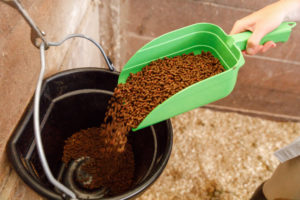Tack and Feed Room Ventilation – Keep the Mold Away

As we deal with heat and humidity, attention is often appropriately focused on the comfort of our animals. We sometimes neglect to think about the impact of heat and humidity on our tack and on our feed. Controlling humidity and temperature with proper tack and feed room ventilation is very important for the success of an equine operation.
Preventing Mold and Mildew in Tack: Useful Steps to Follow
Tack that is exposed to high humidity and warm temperatures can mold/mildew very quickly with resulting damage to leather. The following steps might be useful to consider:
Ensuring Adequate Airflow in the Tack Room
Make certain there is adequate airflow thru the tack room. This may require having windows that allow ventilation or the addition of fans to move air thru the tack room. Locate the air intake and air exhaust areas so that air flows thru the room, not just at ceiling level. If you install exhaust fans, consider where the air will be coming in to reduce exposure to dust or contaminants.
Separating Wet Saddle Pads/Blankets from Leather Tack
Do not store wet saddle pads/blankets in the same area as leather tack. Do not put pads/blankets over the top of saddles on saddle racks.
Proper Storage and Airflow for Saddles on Racks
Make certain there is space between saddle racks to allow airflow between saddles.
Benefits of Using a Dehumidifier in the Tack Room
Consider using a de-humidifier in the tack room. If possible, install so it drains automatically instead of requiring manual emptying of the water container.
Considerations for Tack Room Air Conditioning
If design and electrical wiring are adequate, consider a window air conditioner for the tack storage area.
Importance of Ventilation in the Feed Room
Feed room ventilation is also important. Feed may absorb moisture from the air and mold even if it arrives at the farm at a suitable moisture level from the store or the feed plant. If possible, store feed out of direct sunlight as moisture migration can take place within feed bags, causing moisture to accumulate in one area of the bag. Storing feed in bulk bins also causes moisture to accumulate in one area of the bag. The feed on the sunny side can heat up and cause moisture migration in the bin. The bin should be ventilated to allow moisture to escape but must be set up so moisture does not enter when it rains! Depending on material, bins can be painted with reflective color to help reduce heating.
Tips for Proper Feed Storage and Rotation
During warm, humid weather, avoid purchasing large quantities of feed at one time and ensure proper rotation of feed, using up bags and regularly emptying and cleaning/inspecting bins. Ensure that bags are stacked on pallets or materials that prevent moisture contact/accumulation at the bottom of the stack. Stacking bags directly on top of concrete or dirt floor makes the bottom bags very prone to getting damp and molding.
Managing Pests in Tack and Feed Storage Areas
Pest control is also important for both tack and feed storage areas. Rodents can quickly damage tack and can contaminate feed. Keeping the areas clean and using commercial pest control may be one option to consider.
Ready to ensure your horse is getting the optimum nutrition at feeding time, every time? Find the perfect feed formulated specifically for horse’s needs with our Feed Selector Tool.
